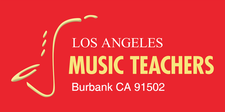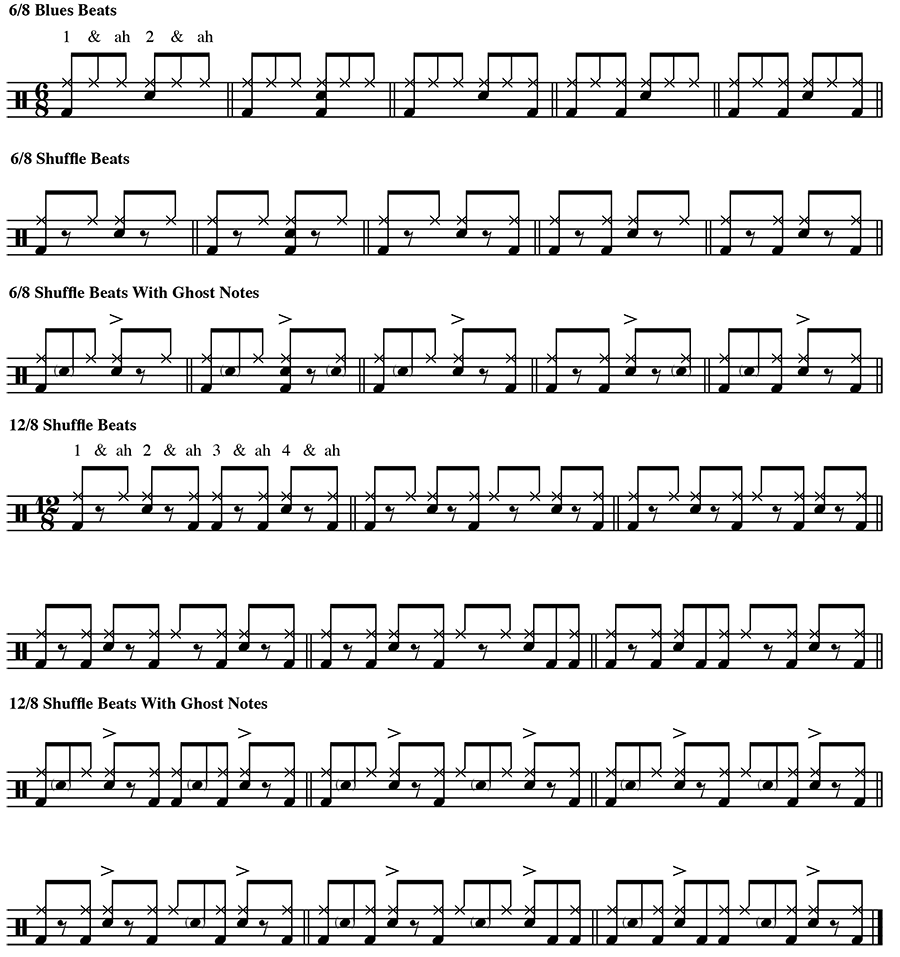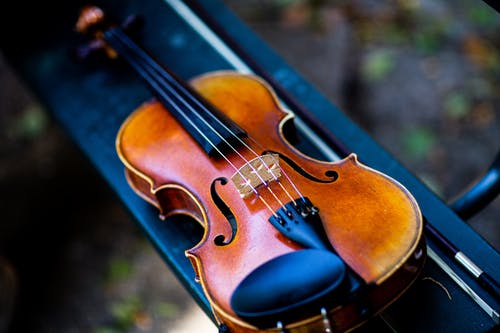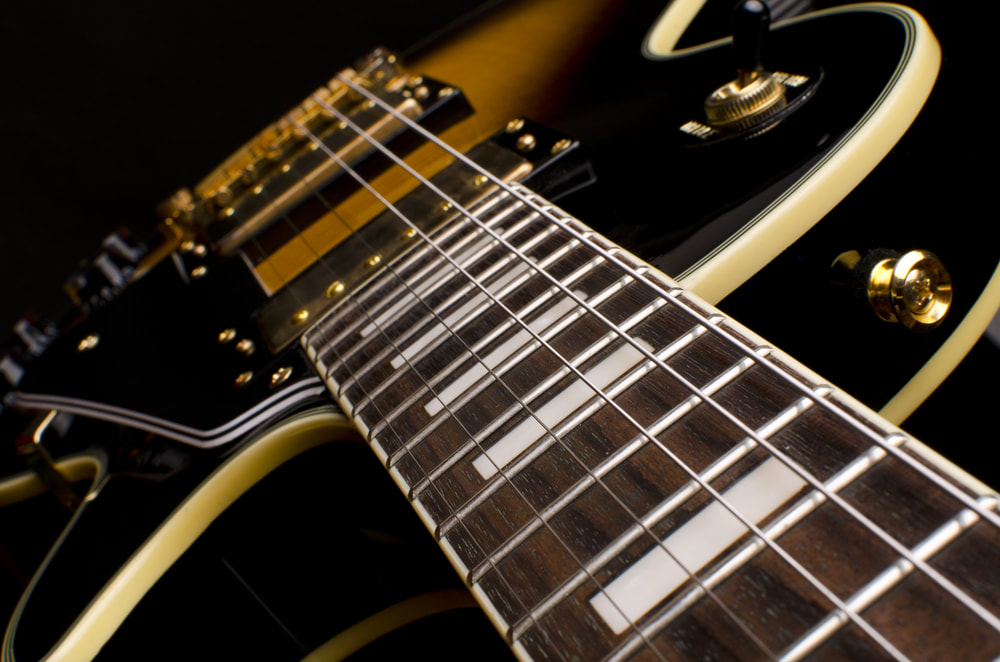How To Play The Shuffle On Drums!
1/30/2023
Can’t play a convincing shuffle? You might as well cross a whole range of potential gigs off your bucket list. Shuffles play a crucial role in every professional drummer’s vocabulary, and those still struggling to get the hang of this particular feel might be surprised to learn there’s a lot more to it than meets the eye. Shuffles can lightly bounce behind a track or drive like a freight train, and everything in between. You may be content knowing a handful of basic patterns, but there are dozens of types of shuffle grooves that can help you develop greater control and coordination while expanding your fluency. So let’s take your shuffle to the next level. WHAT IS A SHUFFLE? As you dig deep into shuffle pedagogy, you’ll find that they’re sometimes written as triplets in 4/4 and other times as 12/8. So, to help you adjust to this idea, we’ve presented the following examples both ways—in either case, they’re more or less equivalent. I’ll refer to both patterns as being counted as 1 & ah 2 & ah 3 & ah 4 & ah because it’s easier to count them that way, even though my music theory teacher would slap my wrists for that. Shuffles generally sound like a child skipping, with a cymbal pattern playing the pattern 1 – ah 2 – ah 3 – ah 4 – ah. However, as you’ll soon see, there are countless variations on this idea. Sometimes the feet play the shuffle, or it’s divided among several limbs, or occasionally it’s just implied. GETTING STARTED For those new to shuffles, we’ll start with a few blues beats that aren’t technically shuffles, but will help you get used to the feel of triplet-based beats. These grooves are written in 6/8, and since they’re shorter, they’re easier to master. Practice each slowly until it becomes comfortable, and then try speeding up the tempo. Keep your snare and bass drum medium strong, and play your hi-hat softer using the tip to create a musically balanced sound. Once you’re comfortable with these, you can link pairs together to create longer and more interesting patterns. The second line has some simple shuffles. When playing these on the ride cymbal, you may close your hi-hat with the snare note. The third line is trickier. To master these, play the unaccented snare notes very softly. More advanced drummers can expand these by buzzing or playing soft drags instead of ghost notes for different textures. Feel free to add variations on the cymbal, foot, or snare patterns to spice up any shuffle once you’re comfortable playing it. If you're interested in taking Drum lessons on Zoom or In Person in Burbank, Glendale or North Hollywood, we have some of the best drum lessons in Los Angeles. Our drum instructors are picked by interviewing hundreds of drum instructors and we have really high standards on both their teaching ability as well as their personality. If you'd like to talk to one of our instructors or set up a first lesson we have a guarantee that if you don't absolutely love your first lesson you don't have to pay for it. Please contact us at (818)902-1233 or on our website at https://www.losangelesmusicteachers.com/online-drum-lessons-in-burbank-ca.html
Best Way To Find Your Voice Range
1/27/2023
If you're interested in taking Singing lessons on Zoom or In Person in Burbank, Glendale or North Hollywood, we have some of the best Voice lessons in Los Angeles. Our Vocal instructors are picked by interviewing hundreds of teachers and we have really high standards on both their teaching ability as well as their personality. If you'd like to talk to one of our instructors or set up a first lesson we have a guarantee that if you don't absolutely love your first lesson you don't have to pay for it. Vocal Range I’m sure we’re all familiar with words like bass, tenor, alto and soprano, but how do we actually find out our voice type when we start singing? Discovering our voice type is in fact a really simple exercise, and certainly one which is worth spending a bit of time on as a beginner. Knowing and understanding vocal range gives us an important guide on the notes and songs we are able to sing safely and effectively. It's important to remember that vocal range really isn’t related to singing ability: many experienced singers can have a narrow vocal range, and are still able to produce a beautiful, rich sound. As vocal range is mainly determined by the shape and structure of each individual's vocal folds, it's difficult to train to reach notes outside our range. However, we can strengthen the notes at the edge of our range, and much of vocal training focuses on improving the quality of the notes at the top and bottom of our register, giving us a wider range to sing with a clear and natural sound. Here are some simple steps for finding your vocal range and voice type: 1. Warm Up Before doing any type of singing, it’s vitally important to do a vocal warm up, particularly when singing near the edges of our vocal range. This is in order to avoid straining or damaging the voice. Simple techniques to warm up the vocal choirs include: humming scales, sirening, and singing scales using different vowel sounds. 2. Find Your Lowest Note Using a piano, find Middle C (also known as C4) and sing along as you play the note. Travel down the white keys to the lower notes and sing along to each note until you reach your lowest note. Any note within the octave of Middle C is designated a number 4, any note in the octave below is designated a number 3, and so on. Your lowest note will be the last note you can sing comfortably and sustain without croaking or breathing the note. Write down the note (for example G3). Once you’re sure you’ve found your lowest note, don’t attempt to try singing any lower as this might strain your voice. 3. Find Your Highest Note Much like finding your lowest note, travel up the piano from Middle C until you find the highest note in your normal voice and write the note down. Continue up the scale in your falsetto voice until you find the last note you can sing and sustain comfortably and again write the note down - this note it is the top of your vocal range. It’s very important not to push your voice and attempt to sing past this note. 4. Compare Your Lowest And Highest Note Once you know your lowest and highest note, check these against the voice types below:- - Soprano: C4 – C6 Mezzo Soprano: A3 – A5 Alto: F3 – F5 Tenor: C3 – C5 Baritone: G2 – G4 Bass: E2 – E5 You've now found your vocal range and voice type. However, it’s important to bear in mind that many singers within the categories above can often sing higher or lower than the ranges displayed, so don't worry if your range doesn't match exactly. The top and bottom note are not the only things to determine voice type: factors such as tessitura (the most comfortable part of the range to sing) and timbre (texture and quality of the voice) also inform voices types. As you gain more experience as a singer you will develop a better awareness of the parts you are able to sing most comfortably comfortably and naturally. If you're interested in taking vocal lessons on Zoom or In Person in Burbank, Glendale or North Hollywood, we have some of the best vocal lessons in Los Angeles. Our vocal instructors are picked by interviewing hundreds of vocal instructors and we have really high standards on both their teaching ability as well as their personality. If you'd like to talk to one of our instructors or set up a first lesson we have a guarantee that if you don't absolutely love your first lesson you don't have to pay for it. Please contact us at (818)902-1233 or on our website at https://www.losangelesmusicteachers.com/online-voice-lessons-in-burbank-ca.html
Styles of Singing for Different Genre's
1/11/2023
Voice Lesson on styles of singing. People have been singing since the discovery of the voice and the beauty of melody. Of course, many things have changed over the hundreds of years people have been singing. Cultures across the globe have with their own scales and modes, and at the same time different type of singing styles emerged. Music genres are diverse and varied as the cultures themselves. Different genres present unique challenges for singers. Here is a list of the most common singing styles and how to sing them. Pop Pop is short for Popular. The pop music of the 40's was Frank Sinatra and Jazz music. In the 50's it was Elvis and Bo Diddly. Each decade was a different style of music right up until the pop music of today. With dance and rhythm at its heart, this style has dominated the music industry. Tips: Learn how to control your vibrato without getting stressed. Experiment with varied vocal sounds like short popping sounds. Focus on your stage movements and gestures and dance a little to set the right energy. Rock Rock is the grandchild of the blues. Rock and roll is heavier and a more danceable rhythm. It grew up t o become harsh, rougher and edgier. Tips: Experiment with different vocal flairs like a growling sound at the end but make sure you don’t overdo it. Practice singing a huge range of dynamics from whispers to high notes. Opera/ Classical This style is always considered as the most formal and restrictive of all genres of singing as it requires the greatest amount of discipline. It is sung with a terminal vibrato and emotional release. Lack of intimacy with the audience makes it the least conversational of all genres. It gives the audience the impression of admiring astonishing paintings from afar. Tips: Listening to the style of the great vocalists will help you to understand the stylistic demands of this difficult style. Don’t force or try to create it. Get connected with classical voice instructor to become a legitimate classical vocalist. Blues/Jazz Songs with clear speech level and distinct consonants come under jazz genre while blues singing has rough and rootsy edges with a unique accent. Tips: Experiment with different vocal sounds like scatting and pitch slides. Listen to great jazz vocalists for understanding the stylistic differences and you can also learn a lot from singing along with great saxophone and horn jazz soloists. Hip Hop The rhythmic rhyming singing accompanied with rapping and beat boxing is termed as hip hop style of singing. The genre has grown steadily and gained popularity over the years. The apparent origins are funk, disco, reggae, and blues. Tips: Carefully listen to funk, disco, reggae, soul, gospel and old-school hip hop songs. Hip Hop is different than rapping. Never be afraid of experimenting or wordplay. Make your own unique signature singing styles. Despite the different music genres, one thing connects them all that is love that the audience has for the voice and great vocalists no matter what style. Practice makes perfect. Listen carefully and learning some piano skills will also help you to develop faster because learning about scales and chords is important for your development. If you're interested in taking vocal lessons on Zoom or In Person in Burbank, Glendale or North Hollywood, we have some of the best vocal lessons in Los Angeles. Our vocal instructors are picked by interviewing hundreds of vocal instructors and we have really high standards on both their teaching ability as well as their personality. If you'd like to talk to one of our instructors or set up a first lesson we have a guarantee that if you don't absolutely love your first lesson you don't have to pay for it. Please contact us at (818)902-1233 or on our website at https://www.losangelesmusicteachers.com/online-voice-lessons-in-burbank-ca.html
As much as every budding violinist would love to pick up their instrument and begin playing beautiful music, the work required to get there is much more mudane. Every breathtaking performance requires strategic and focused warm up exercises beforehand. These routines help develop and maintain your basic violin skills as well as gear for more advanced techniques too. For beginners, it may be difficult to know even where to start; after all, everything seems to need work. However, using the beginning of each practice session for a warm up will optimize each days result and pave the way for strong playing for months and years to come. Although warm up excursuses will vary from person to person based on the advice of your violin teacher, there are certain exercises that can benefit everyone. Here are five beginner violin tips that will help you grasp the fundamentals. 1. Long Open Strings Playing long open strings does several things: it lets your practice consistent intonation from each stroke, it allows you to become familiar with your bows weight and speed across the strings and lastly, it helps ensure that your bow remains in the proper location on the strings in relation to the bridge. Look into a mirror and place the bow on the string in the proper point and pull the bow across the string, listening for a clear, clean and consistent note. As you play, continually check in the mirror for your bows contact point. Repeat at least five up and down bows before moving on to the next string. 2. Finger Placement Correct finger placement is essential for playing the right notes on the violin, and to learn this correctly, you must practice! One of the tried and true beginner violin tips is to play simple scales in first position. This trains your finger to understand where they belong on the fingerboard in relation to other fingers, and it trains your ear to hear each note as it should be played. To practice, pick any scale, and play each note slowly, separately and precisely. Always play with a tuner so that you can tweak your fingers placement for a proper intonation. 3. Fourth Finger Practice Placing your fourth finger on a string creates the same note as the subsequent higher open string. Some beginner violinists use the open string to play the note because it is much easier and you know that the note will be correct. However, as you advance, there will be times where you cannot access the open string to play the note, or it is much less efficient to do so. Therefore, you need to strengthen your pinky finger! Start by playing the open string, then mimic the note using your pinky on the lower string about five times for each string. Listen carefully - does the fourth finger note match that of the open string? Don’t get discouraged if its difficult to even stretch your pinky at first - it will take time for it to gain strength and flexibility 4. Slurs A slur allows you to play two or more notes in a single bow stroke. To do this, start by placing the end of your bow close to the frog on the string. As you slowly but steadily bring your bow across the strings, place and then remove your first finger in the proper place while keeping your bow straight. Also, make sure that you place your finger on and off the strings at regular intervals - using a metronome will help. Start with two notes per stroke. 5. String Crossing The final of the beginner violin tips is the ability to make a clean change from string to string while playing. Keep your elbow at a right angle to form a square - include the bow and trace an imaginary line from your shoulder to prove where the bow hair touches the string. Rock the bow to each string while practicing your long bow strokes. Make sure that your arm and bow remains in the same plane and use the natural weight of your arm on each string. Because these warm up exercises set the tone for your practice session and for your learning overall, always perform them with focus and intent. They don’t need to take long, a dedicated five or 10 minutes should be fine. If you are unsure of what to practice or how to practice, ask your violin instructor for some violin tips - they have the knowledge and experience to guide you in the right direction If you're interested in taking Violin lessons on Zoom or In Person in Burbank, Glendale or North Hollywood, we have some of the best Violin lessons in Los Angeles. Our violin instructors are picked by interviewing hundreds of violin instructors and we have really high standards on both their teaching ability as well as their personality. If you'd like to talk to one of our instructors or set up a first lesson we have a guarantee that if you don't absolutely love your first lesson you don't have to pay for it. Please contact us at (818)902-1233 or on our website at https://www.losangelesmusicteachers.com/online-violin-lessons-in-burbank-ca.html
Top 10 Guitar Styles To Learn Online
1/2/2023
Top 10 guitar styles to learn online with Los Angeles music teachers Several cultures have managed to influence the way the guitar is played in times gone by. Today, there are various ways of playing the guitar. Learners need to understand the various playing styles available so as to be able to choose a suitable guitar style. It is highly recommended to avoid monotonous tendencies by learning various styles of play. Undoubtedly, you stand to gain more impressive recognitions among friends and colleagues when you learn to play in varying guitar styles. Interestingly, the guitar space is so diversified to the extent that players can colorfully create their own styles by simply learning more musical scales and techniques. Here are some of the top styles to learn on guitar to help you improve your own playing skill. Rock The electric guitar is mainly used to create the rock music style it features a typical 4/4 beat that is influenced by country, rhythm, and blues, and blues music. Rhythm Learners will need to understand how to support a vocalist with the right beat when playing the rhythm guitar. Percussive Of all top styles to learn on guitar, the percussive could be the most challenging as it requires lots of practice to master. Aside from playing on the strings, players will need to learn how to produce percussive sounds by hitting the body of the guitar with their nails, finger edge or palm. Lead Virtually any type of guitar can be used to play a solo and practice several other techniques for lead improvisations. Jazz Typically characterized by improvisations and polyrhythms, swing and blue notes, this is an independent art form of music that can be purely instrumental. When playing on a jazz guitar, it important for learners to understand its complicated chord structures. Folk Anyone can pick up a folk guitar to play in a piece of folk music as it doesn’t require any form of professionalism. All you need to do is to flow along with the story that is sung about common people. Flamenco Flamenco features a vigorous Spanish style of play that involves fast and dynamic movements. Playing the flamenco guitar can provide the groove to the dancer by establishing percussive hits through a distinct picking pattern. Slide Learning to play the slide guitar will also require you to learn how to change pitch with the slide instrument. Bluegrass Originating from the southern United States, this unique style of country music features a happy spirited, fast tempo that is supported with a resonating guitar on the bass line. Blues Often performed over a repetitive harmonic pattern, blues is a melancholic style of music that features a simple chord progression presented in a slow sad manner. During musical performances, the guitarist often serves as the main point of focus. If you're interested in taking Guitar lessons on Zoom or In Person in Burbank, Glendale or North Hollywood, we have some of the best guitar lessons in Los Angeles. Our guitar instructors are picked by interviewing hundreds of guitar instructors and we have really high standards on both their teaching ability as well as their personality. If you'd like to talk to one of our instructors or set up a first lesson we have a guarantee that if you don't absolutely love your first lesson you don't have to pay for it. Please contact us at (818)902-1233 or on our website at https://www.losangelesmusicteachers.com/online-guitar-lessons-in-burbank-ca.html
|
Archives
July 2024
Categories
All
|
|
Music Lessons Available on All Instruments:
Piano Lessons
Guitar Lessons Voice Lessons Drum Lessons Violin Lessons Cello Lessons Saxophone Lessons Jazz Improvisation Lessons Flute Lessons Clarinet Lessons Singing Lessons Acoustic & Elec Bass Songwriting & Production |
Contact Us Now
|
Website by Never Alone Business Services






 RSS Feed
RSS Feed



